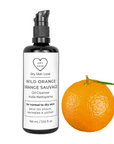

BEST SKINCARE FOR DRY SKIN
Dry Skin Love Wild Orange Oil Cleanser for Dry Skin
Best Oil Cleanser for Dry Skin
Dry Skin Love Wild Orange Oil Cleanser is a sensual oil cleanser for normal to dry skin.
Crafted with nutrient-rich plant oils, flowers, microalgae extract and aromatic essential oils.
Gently removes makeup, sunscreen and skin debris, while nourishing dry skin. Leaves your dry skin clean, soft and plump.
Created by scientist Dr. Natasha Ryz
Size = 100 ml / 3.52 oz
Best Oil Cleanser for Dry Skin
Like a Mini Spa!
"As a new mom, time for self care has been extremely hard to come by. This wild orange oil cleanser has been a game changer for me in that department. It is so luxurious and incredible at brightening and freshening up my otherwise tired looking and dry skin. My favourite way to use it has been as a mask before taking a quick shower. It feels (and smells!) like a mini spa treatment every time. Definitely recommend!"
Ganive
Victoria, British Columbia, Canada
Best Oil Cleanser for Dry Skin
Dry Skin Benefits
Clean. Soft. Protected.
Wild Orange Oil Cleanser is a luxurious oil cleanser that makes your dry skin feel clean, soft and protected.
Wild Orange Oil Cleanser is packed with potent plant ingredients, including nutrient-rich plant oils, herbs, flowers, microalgae extract and aromatic essential oils.
After using our Wild Orange Oil Cleanser, you will notice an improvement in the texture and appearance of your dry skin.
Your skin will look plumper and the appearance of fine lines will be minimized.

Best Oil Cleanser for Dry Skin
Great for Aging Skin!
"This was the first oil to milk cleanser that I've tried and I really enjoyed it. The scent is light and fresh and the texture is luxurious and doesn't leave your skin oily, as you might imagine. As a woman in her mid 40's my skin gets dry, especially in the winter. This is a great product to bring some much needed moisture and softeness back to my skin."
Rachel C.
West Lorne, Ontario, Canada

Best Oil Cleanser for Dry Skin
Delightful Aroma
The delightful aroma of Dry Skin Love Wild Orange Oil Cleanser has top citrus notes of wild orange and bergamot, sweet, complex and mouth-watering.
At the heart coriander and chamomile flowers are rich and creamy.
At the base vanilla bean and virgin coconut provides warmth and comfort.
The sensual aroma of wild orange, coriander seed and vanilla bean is fresh, rich and comforting.
No artificial fragrances.
100% natural aroma.
Best Oil Cleanser for Dry Skin
Feels Wonderful
"This wild orange cleanser soothes my sensitive skin and exceeds my expectation! Each morning and evening I feel like I am getting a special treat. And I have to remind myself to add my moisturizer as my skin already feels soft and smooth."
Katherine R.
Minnedosa, Manitoba, Canada

Best Oil Cleanser for Dry Skin
Wild Orange Oil to Milk Face Cleanser
Cleanse, soothe and delight.
Envelope yourself in a sensory delight - from the mouth-watering aroma, the rich texture, and the soothing finish.
All are designed with your maximum pleasure and delight in mind.
The Wild Orange Oil Cleanser helps you connect with your senses and with yourself.
It provides a ritual and a daily moment just for you.
A moment of luxury.
Best Oil Cleanser for Dry Skin
Best Face Cleanser!
"I am 76 and have been using expensive face products my entire adult life. This is the best face cleanser I have ever used. When I remove it with a moist face cloth it leaves a film of oil on my face which is absorbed within minutes. I now look forward to bed time every night knowing I get to use it!"
Alison L.
Ottawa, Ontario, Canada
Best Oil Cleanser for Dry Skin
Natural Ingredients
Wild Orange Oil Cleanser is made with nutrient-rich plant oils, herbs, flowers, microalgae extract and aromatic essential oils.
We choose natural plant ingredients that are minimally processed and unrefined so they retain their nutrients, color and aromatic compounds.
We put incredible thought and effort into sourcing our precious ingredients for our oil cleanser.
Every single ingredient has benefits for your skin.

Dry Skin Love Wild Orange Oil Cleanser
Full Ingredients
Helianthus annuus (Sunflower) seed oil*¹, Pyrus malus (Apple) seed oil¹, Ricinus communis (Extra Virgin Castor) seed oil*¹, Cocos nucifera (Extra Virgin Coconut, Fairtrade) oil*¹, Polyglyceryl-4 Oleate, Simmondsia chinensis (Golden Jojoba) seed oil*¹, Vitamin E oil, Citrus sinensis (Sweet Orange) essential oil*, Citrus sinensis (L.) Osbeck (Wild Orange) essential oil, Citrus aurantium var. bergamia (Bergamot FCF bergapten-free) essential oil*, Matricaria recutita L. (Blue Chamomile) CO2 extract*, Vanilla planifolia (Vanilla Bean) CO2 extract*, Matricaria recutita L. (Chamomile) flower extract*, Coriandrum sativum L. (Coriander Seed) essential oil*, Pogostemon cablin* (Patchouli) essential oil*, Astaxanthin (Haematococcus pluvialis), Limonene, Linalool
*Certified Organic Ingredients
¹Cold Pressed Oil
Polyglyceryl-4 oleate is a natural emulsifier made from sunflower seed oil and vegetable glycerin.





